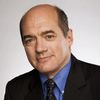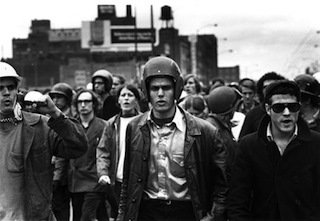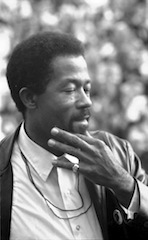Part Two: How both the Nolan Chart and Libertarian Party were influenced by the SDS
In 1965, Carl Oglesby assumed leadership of the student-activist organization (Students for a Democratic Society aka the SDS). This change reflected what I believe was an ideological shift in America's left wing: from the East Coast intellectual tradition to the New Left emerging from the Midwest.
After one Sunday service at our former church in Ann Arbor, Carl asked to practice a new speech, which later became quite well-known as "Let Us Shape the Future," in front of the church membership. He had planned to deliver in at the March for Peace in Vietnam, held in D.C. on November 27th, 1965. I was thirteen at that time, and had been elected president of the Unitarian Church youth groups in both Ann Arbor and Flint. Watching him in action within the organization, I came to idolize Carl.
The Parish House where the War Council took place in 1969.
As we listened, we noticed that Carl used the word "coordinates" to describe issues where he believed the Left and Right shared common ground. This led us into a discussion of the limitations of the Left/Right line chart, which was often used to illustrate a person's political views.
LEFT---------------------------------------RIGHT
The Left/Right chart plotted a person's political leanings along a line depending on where one stood on issues of economic and personal freedom. The chart was based on the assumption that people on the Right were focused on economic freedom, while those on the Left were more concerned with personal freedom. Carl was trying to explain in his speech that plotting our political ideologies in this way had created a false Left/Right dialectic--one that made Democratic and Republican viewpoints seem hopelessly in conflict.
My father understood Carl, but he knew there was better way to explain this important discovery. Knowing my love for math, he asked me to diagram Carl's concept. Eager to show off, I grabbed a piece of chalk and drew an X and a Y axis. I labeled them economic freedom and personal freedom. This diagram eventually came to be known as the Nolan Chart, named for David Nolan.
This simple chart opens up the political landscape, prompting readers to re-think political assumptions. For example, when using the old Left/Right line chart, it is hard to say whether Ron Paul or Rick Santorum is more "conservative." But, using two axes creates new options. Without the Nolan Chart, words lose their meaning and analytical power.
My great friend David Nolan and I met when we served on the executive and platform committees of the 1970s Libertarian party. Nolan first published his version of the chart in the January 1971 issue of The Individualist, a monthly magazine distributed by the Society for Individual Liberty (SIL). The Nolan Chart became the defining document of the Libertarian party, which Nolan founded in December of 1971 using ideas developed by Thomas Jefferson, Carl Oglesby, Murray Rothbard, Ayn Rand, Henry David Thoreau, and F.A. Hayek.
Incidentally, in 1972, I presented to Nolan and Rothbard the idea of a three dimensional chart, making it a cube and adding the concepts of legality and morality. While they both loved the idea, it was too complicated for widespread use. This would enable people who are against for example drug use to oppose it morally without asserting or staking control over other adults based on that belief.
His mentor, economist Murray Rothbard, another central figure in the early Libertarian Party, reviewed Carl's speech in late October. I still remember Carl poring over the speech a week before he went to Washington, and I also recall Murray phoning Carl on a Sunday to give him some last-minute feedback. We all knew it would be an important speech, but we didn't realize how lasting its effect would be on the political landscape of our nation. (Read the speech here). On November 27, 1965, roughly 35,000 filled D.C.'s National Mall to hear Carl's speech, which he expected to give to a crowd of 5,000. My parents and I had ringside seats.
His historic speech took the anti-war movement to a higher level and is widely viewed as one of the greatest speeches of the 1960s. I was personally inspired by it more than twenty years later, when I adapted Carl's speech, calling all to take ownership of their future, as the tagline for my foundation, The Network for Teaching Entrepreneurship, "Owning Your Future."
After the speech, Carl was mobbed, and we weren't able to talk to him. In early 1966, however, he called our house and asked me to head the SDS outreach for youth under fifteen. I eagerly agreed, and began to write papers in my sprawling, crooked handwriting, advocating anti-war actions like a student strike, which had virtually no impact at Zimmerman Junior High or at Flint Southwestern High School. I recruited a whopping three members to the anti-war movement.
When he invited me to meet with him and other SDS members in Ann Arbor, I was thrilled. I walked into the meeting at the Brown Jug assuming that everyone there would be on the same page--that we were all anti-war, pro-democracy and fans of both economic and personal freedom. I was in for an unpleasant awakening.
Although the SDS had always been an anti-communist organization, it was being infiltrated by the Progressive Labor Party (PLP, see), a Communist-front group that in 1965, would be successful in removing the anti-communist plank from the SDS's platform.
J.J. Jacobs
I was stunned after meeting with the new incarnation of the SDS. Carl later said he should have warned me that there were now two parts of the SDS: one led by him and Murray, which supported private ownership, aligned with small business and protected the free market; and one concluded that democracy came from decentralization of wealth and power. The Marxist side believed in a communist takeover of the world based on Lenin's strategy.
This was my first experience with the small radical sect, and it left me pretty shaken. I was shocked to realize how little these young activists had read, unaware of the critical debates against the labor theory of value made by Carl Menger, Ludwig von Mises, F.A. Hayek, and Milton Friedman.
They were even unaware of the differences between Trotsky and Lenin. Even accepting their economic and political illiteracy, I could not believe that they had not heard of Khrushchev's speech, a seminal indictment of Stalin by his successor. Although they said they were Marxists, they were unaware of the Manifesto of Equals, the key document for justification of mass murder. I didn't fully grasp the implications of the factional struggle that was emerging with the SDS, which is why I want to communicate this history now to young people who are getting involved with the New SDS.
Carl Oglesby.
At this time, my primary focus was how to get working-class youth to rally against the war. Even then, I was a fan of small business, and I outlined my belief that young people could free themselves from the working-class by becoming entrepreneurs instead of laborers. Basing my arguments on the classical liberal literature of Mises, Jefferson, Schumpeter and Hayek, I also argued that any entrepreneur should reject war because of its negative impact on trade and political freedom. Carl copied my papers and read them to local SDS groups. He liked my ideas enough to put me in charge of developing SDS strategies for high-school and junior-high students.
Carl and my mother had a falling out when Carl left his wife for another woman. My mother was also displeased that Carl had become aligned with Black Panther Party member Eldridge Cleaver, who had spent ten years in jail for serial rape. Cleaver gave a rousing speech at the 1968 Peace and Freedom Party convention in Ann Arbor, and was invited to meet with our church group where someone yelled, "He's a rapist pig!"
Nonetheless, Carl Oglesby and Eldridge Cleaver became friends; as Cleaver was pro-small business and supported political rights.
Eldridge Cleaver.
In March of 1969, Carl traveled to the national SDS meeting in Austin where he was blindsided, confronted by the executive committee of the SDS about the "incorrectness" of his political thought. The SDS leadership had become increasingly radical and they denigrated Carl in front of the membership for his willingness to work with businessmen, and his commitment to nonviolence, insisting it was time "to take up the gun." By the end of the session, Carl had been forced out as a spokesperson of the SDS: "the SDS has evolved, Carl has fallen behind," they declared.
Years later, Carl obtained 4,000 pages of secret government notes through the Freedom of Information and Privacy Act. These helped him recall the events and conversations he detailed in Ravens in the Storm: A Personal History of the 1960s Antiwar Movement (Scribner 2008).
Afterwards, the new leadership--consisting of Bernardine Dohrn, Bill Ayers, David Gilbert, Mark Rudd, Naomi Jaffe, and Diana Oughton--held a "War Council" in Flint. Mark Rudd's father was in the Air Force, and all leadership came from middle- or upper-class families. They held a pre-meeting at the Howard Johnsons, where John Jacobs fired me from my post as an SDS youth leader for my pro-democracy, pro-entrepreneurship, and anti-communist views.
This story will emerge in Part Three, my final installment of this series on the history of the Students for a Democratic Society, and I will also describe how it was brought down by young Marxists using the murderous tactics of Debray.





